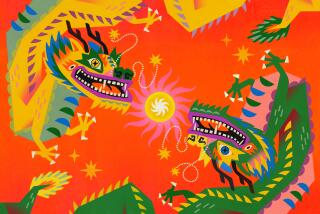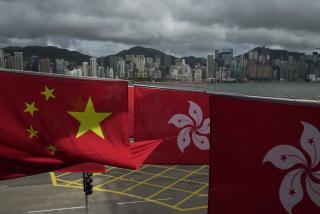Hong Kong to Tout New Brand: Itself
- Share via
HONG KONG — In Europe and the United States, rivalries between cities often bubble to the surface during sporting events such as the European Cup soccer championships or a National Basketball Assn. playoff series.
On the far edge of the Pacific Rim, Hong Kong has launched a new strategy to take on other cities in Asia’s national sport: making money. To boost its image and lure investors and tourists, the territory has taken on a bright new logo (a yellow-and-red dragon) and a pretentious slogan (“Asia’s world city”) and is launching senior officials on a tour of 30 cities and a dozen countries to sell it all.
In marketing parlance, Hong Kong is reinventing itself as a global brand.
“Our vision is to make Hong Kong play the same role as London plays for Europe and New York plays for North and South America,” the territory’s chief executive, Tung Chee-hwa, explained at the unveiling last week.
Hong Kong’s marketing gambit reflects the intense jostling for primacy among financial centers in a part of the world where prosperity often depends more on strong foreign investment and solid trade ties than domestic resources.
Like any global ad campaign, Hong Kong’s remake isn’t cheap. Market research alone ran nearly $1.2 million. The dragon, the slogan and the campaign to sell the freshly minted image are all extra.
But the stakes are also high.
“We need to do this if we are to expand investment, trade and other links that are so important to our economy and our continued development as a world city,” Sandra Lee, Hong Kong’s secretary of state for economic services, told a business lunch Monday in Amsterdam.
The stylized dragon--crafted from the Chinese characters for Hong and Kong, which together mean “fragrant harbor,” plus the English letters H and K--is a subtle reminder of the territory’s links to mainland China, the world’s biggest consumer market. The symbol was said to be clearly favored by focus groups over alternatives that included a pearl, an exploding sun, a kaleidoscope and a bamboo motif.
Still, some local art designers happily panned the symbol. “An Oriental cliche,” declared Charles Ng of the Hong Kong Designers Assn. Wan Ching-li, a professor of fine art at the University of Hong Kong, dismissed the dragon as a mainland symbol and argued that a phoenix would have better captured Hong Kong’s unique resiliency.
“The Dragon Is About Strength, Vitality . . .”
Nonsense, countered Kerry McGlynn, deputy director of Hong Kong’s Information Services Department and one of the campaign’s main architects.
“Hong Kong is a proud part of China but a special part,” he said. “The dragon is about strength, vitality, energy and dynamism.”
The launch of Hong Kong’s dragon has set a new standard of image hype for Asian cities. Singapore’s lion, introduced 15 years ago, has been used as a promotional tool, but it was conceived as a symbol for nation-building, not for international marketing.
A P-shaped character on all Shanghai license plates has for some become a symbol for mainland China’s go-go city, but it too falls short of a marketing brand.
“The common logic is that Hong Kong is still ahead of the curve,” said Tom Gougarty, executive director of the American Chamber of Commerce in Shanghai. “It’s a city that doesn’t want to be second to anyone.”
Hong Kong’s marketing offensive appears to be well timed. A decade of recession has sucked much of the dynamism from Asia’s biggest business center, Tokyo. Singapore’s future is clouded by slow growth and political uncertainty among its Southeast Asian neighbors.
Edge Over Shanghai in Key Areas of Commerce
The city that Hong Kong most fears as aregional competitor--Shanghai--is closing in fast as China’s economy booms. But it has yet to establish such fundamentals as banking transparency and a well-defined rule of law, and suffers from the absence of fully convertible currency.
“I think Hong Kong has a chance to continue developing as a financial center, where Shanghai would be, for the time being, handicapped,” Hong Kong Financial Secretary Antony Leung told reporters.
Senior government officials say Hong Kong’s campaign was first conceived--but then put on hold--three years ago to help rescue the territory from an especially disastrous period after its July 1997 return to Chinese sovereignty--a time of steep recession, a drop in tourism, a disease outbreak that required the slaughter of more than 1 million chickens and a red tide that hit marine life like a biblical plague.
Today, however, these officials peddle a brighter picture with gusto, replete with a barrage of TV spots, colorful flags, photo shoots with well-known icons such as movie idol Jackie Chan, and a slick three-minute video that Hong Kong’s main airline, Cathay Pacific, will show on its flights.
The new dragon is scheduled to make its first mainland appearance this month emblazoned on the nose of a chartered aircraft taking a delegation of Hong Kong government and business leaders to view investment opportunities in China’s underdeveloped west.
Cheerleaders for the territory have even had the chutzpah to cite last week’s street protests as a sign of the territory’s freewheeling ways and freedom of expression. Local authorities worked so hard to stifle those same protests in the presence of Chinese President Jiang Zemin that they drew public criticism from several Western governments, including the United States.
“This isn’t a marketing campaign that will be gone in six months,” McGlynn said. “It’s a program that will be ongoing. We’re in this for the long haul.”
More to Read
Sign up for Essential California
The most important California stories and recommendations in your inbox every morning.
You may occasionally receive promotional content from the Los Angeles Times.













